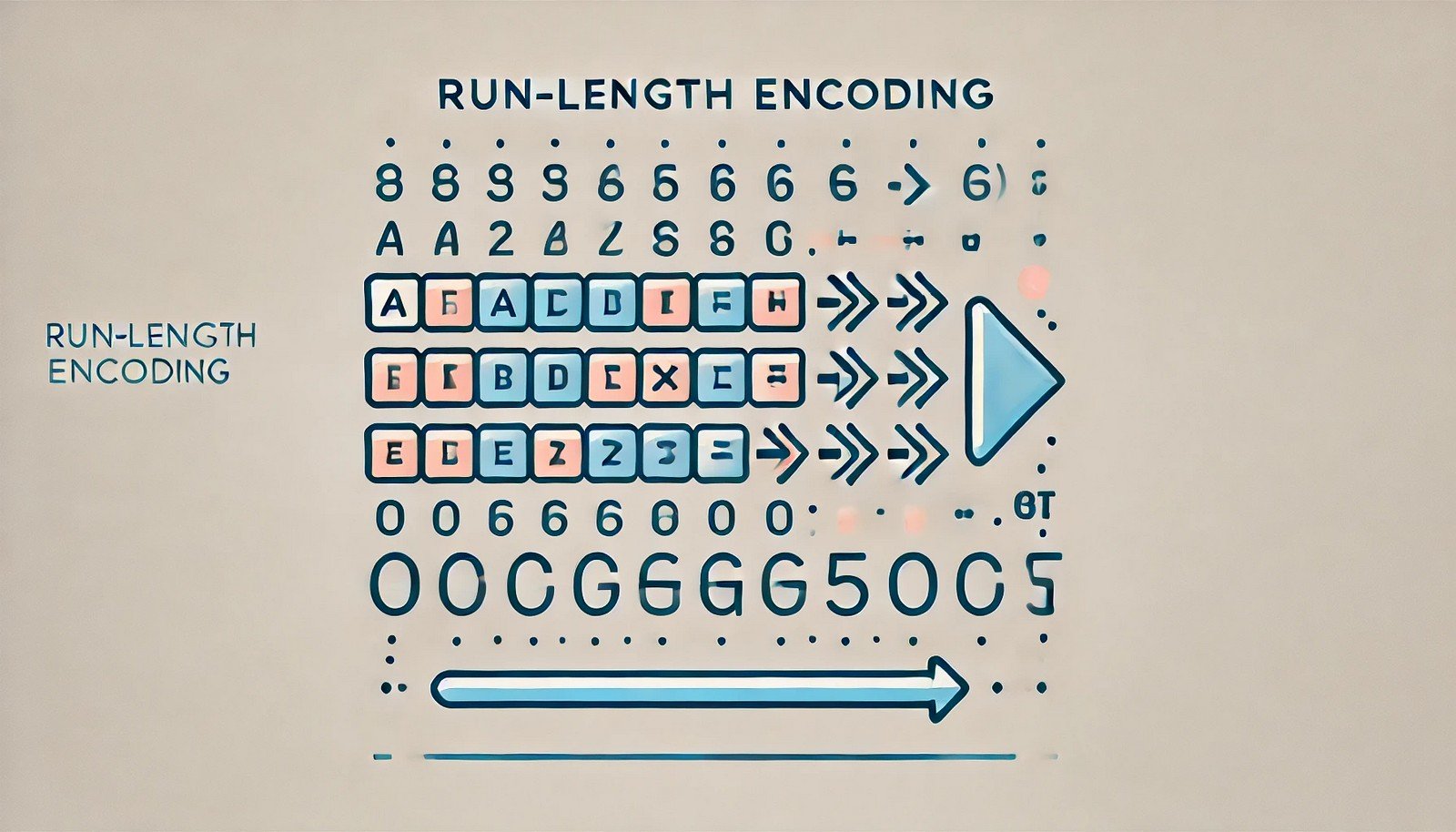Run-Length Encoding
 (Representational Image | Source: Dall-E)
(Representational Image | Source: Dall-E)
Quick Navigation:
- Run-Length Encoding Definition
- Run-Length Encoding Explained Easy
- Run-Length Encoding Origin
- Run-Length Encoding Etymology
- Run-Length Encoding Usage Trends
- Run-Length Encoding Usage
- Run-Length Encoding Examples in Context
- Run-Length Encoding FAQ
- Run-Length Encoding Related Words
Run-Length Encoding Definition
Run-Length Encoding (RLE) is a simple form of data compression where sequences of identical data elements (such as characters or numbers) are stored as a single data value along with a count representing the number of repetitions. Instead of storing "AAAAA" as five separate characters, RLE represents it as "A5," reducing storage space. RLE is most effective on data containing long runs of repeated values, such as monochrome images, simple text patterns, or uncompressed bitmaps.
Run-Length Encoding Explained Easy
Imagine you are packing for a trip and instead of writing "Socks, Socks, Socks, Socks, Socks," you just write "Socks x5." That way, you save space in your list and still remember how many you need. Run-Length Encoding works the same way for computers—it replaces repeated items with a shorter way of saying how many there are.
Run-Length Encoding Origin
Run-Length Encoding has been used in data storage and transmission since the early days of computing. It became widely recognized in the 1960s when digital communication required efficient ways to reduce redundancy in data streams. RLE found early applications in facsimile (fax) machines and simple image compression.
Run-Length Encoding Etymology
The term "Run-Length Encoding" comes from the method itself: a "run" is a sequence of identical items, and "length" refers to how long that sequence is. "Encoding" means turning this information into a compressed format.
Run-Length Encoding Usage Trends
Although RLE is not widely used for general-purpose compression today, it remains useful for specific applications. It is a key component in lossless image compression formats like BMP and PCX. Additionally, RLE is often used in simple telemetry data storage, barcode encoding, and run-based data transmission protocols.
Run-Length Encoding Usage
- Formal/Technical Tagging:
- Data Compression
- Lossless Encoding
- Image Processing - Typical Collocations:
- "Run-Length Encoding algorithm"
- "RLE compressed format"
- "Applying RLE to bitmap images"
- "RLE-based data storage"
Run-Length Encoding Examples in Context
- A black-and-white bitmap image with long sequences of black or white pixels can be efficiently compressed using RLE.
- Fax machines historically used Run-Length Encoding to reduce the data needed to transmit scanned documents.
- Simple animations, such as sprites in early video games, often stored frames using RLE for efficient memory use.
Run-Length Encoding FAQ
- What is Run-Length Encoding?
Run-Length Encoding (RLE) is a compression technique that replaces sequences of repeated values with a single value and a repetition count. - How does RLE work?
It replaces consecutive repeated values with a pair: the value and the number of times it appears. - Where is RLE used today?
It is used in BMP image compression, fax transmissions, barcode encoding, and certain telemetry systems. - What type of data benefits most from RLE?
Data with long sequences of repeated values, such as black-and-white images or simple text patterns. - Does RLE work well for all types of data?
No, RLE is inefficient for data without many repeated elements, as it may increase file size instead of reducing it. - How does RLE compare to other compression techniques?
It is simpler and faster but less effective than more advanced compression methods like Huffman coding or LZW. - Is RLE a lossy or lossless compression method?
RLE is a lossless compression method, meaning no data is lost during compression. - Can RLE be combined with other compression techniques?
Yes, it is often used alongside Huffman coding or dictionary-based methods to improve efficiency. - Why was RLE important for early computing?
It provided an easy way to reduce storage and transmission costs for simple graphical and text data. - Does modern computing still use RLE?
While it is not a primary compression method, RLE remains useful in specialized applications such as remote sensing and simple data transmission.
Run-Length Encoding Related Words
- Categories/Topics:
- Data Compression
- Encoding Algorithms
- Image Processing
Did you know?
Run-Length Encoding played a crucial role in early television broadcasting systems, where it was used to compress video signals. This technique allowed analog signals to be digitized and transmitted more efficiently, paving the way for modern digital broadcasting.
PicDictionary.com is an online dictionary in pictures. If you have questions or suggestions, please reach out to us on WhatsApp or Twitter.Authors | Arjun Vishnu | @ArjunAndVishnu

I am Vishnu. I like AI, Linux, Single Board Computers, and Cloud Computing. I create the web & video content, and I also write for popular websites.
My younger brother, Arjun handles image & video editing. Together, we run a YouTube Channel that's focused on reviewing gadgets and explaining technology.



Comments powered by CComment